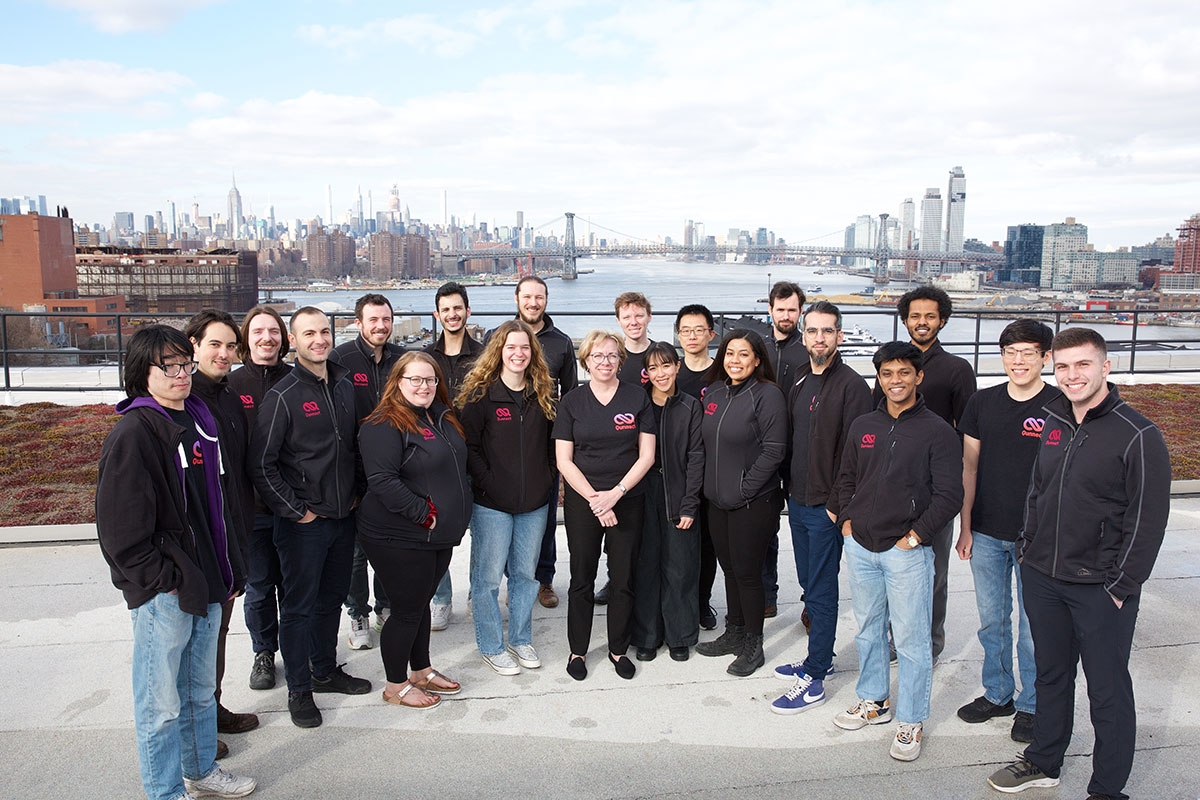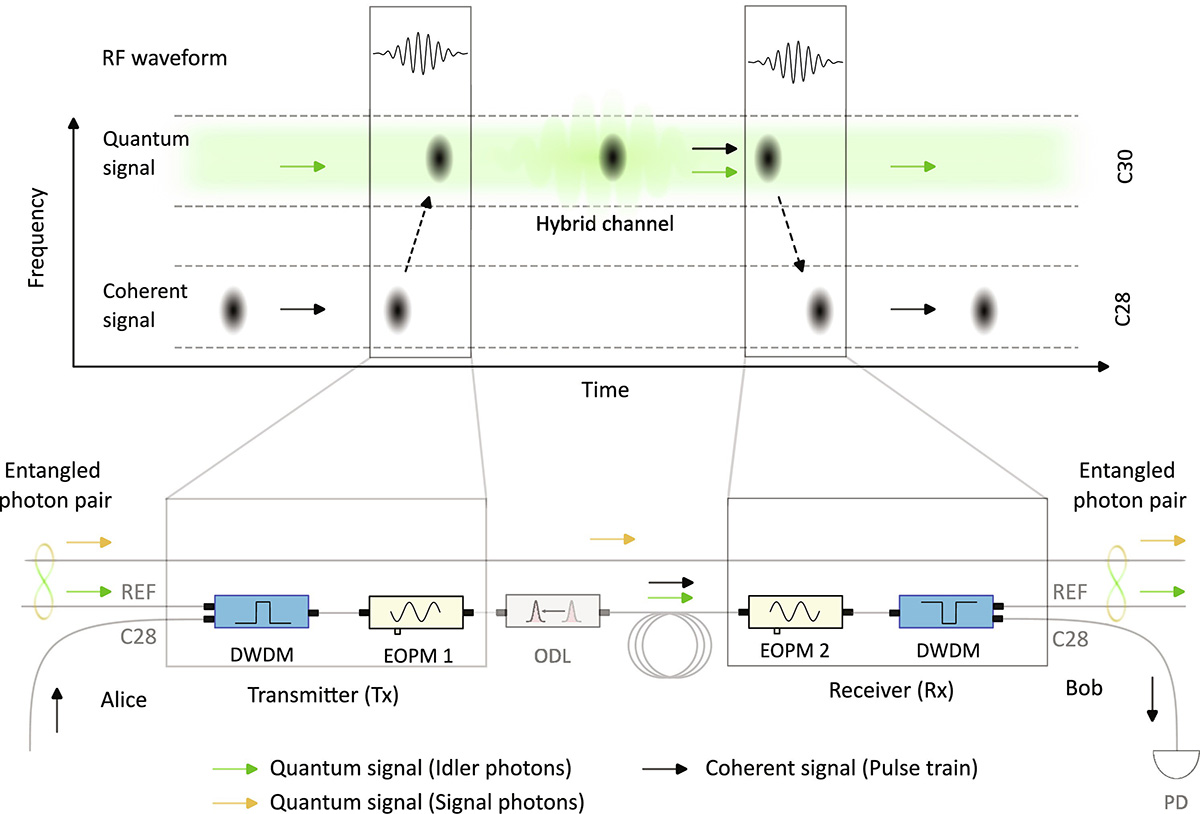![]()
[Image: Y. Chino / Getty Images]
The vast global skein of installed telecom fiber offers one obvious platform for the quantum communications networks of the future. But while proof-of-principle experiments have demonstrated the distribution of quantum-entangled photons in fiber in the lab, and even across some transcontinental and subsea links, the quantum fiber channel poses some knotty practical problems in the real world.
For example, how can delicate quantum information be maintained amid the noise and stresses that harass optical fiber in dense urban networks? And can quantum-entangled photons play well in installed fiber networks already crowded with conventional non-quantum communications? Two recent papers offer some intriguing potential answers.
Entangled qubits take on New York City
One of the degrees of freedom (DOFs) that could be used in fiber networks to encode information in photonic quantum bits, or qubits, is the photons’ polarization state. An advantage of photon polarization qubits is that they’re convenient to manipulate and measure.
When photons are transmitted through fiber, however, polarization is subject to wavelength-dependent dispersion or rotation. Even worse, the amount of polarization dispersion will tend to “drift” over time as the fiber is subjected to ongoing stresses, be they pressure, temperature, vibration or bending. That makes it hard to maintain high-fidelity distribution of polarization-entangled photons with the long network uptimes—hours or days at a time—that would be required in a real-world fiber quantum network.
The Qunnect staff, backed by the celebrated New York City skyline. [Image: Qunnect]
Researchers from a New York–based startup firm, Qunnect, have now demonstrated a possible solution to the quandary (PRX Quantum, doi: 10.1103/PRXQuantum.5.030330). The team’s answer combines a narrowband entangled-photon source and a polarization compensation system that automatically monitors and adjusts for polarization drift. The combination allowed the team to execute high-fidelity polarization distribution across deployed commercial fiber in noisy New York City, over 15 straight days—with uptimes approaching “always-on” levels.
An installed-fiber testbed
As a first step, the Qunnect team carefully measured the polarization dispersion characteristics of its “GothamQ” fiber testbed—a 34-km-long loop, leased by Qunnect from the communications infrastructure provider Crown Castle, that spanned the NYC boroughs of Brooklyn and Queens. To assess the fiber’s operational dispersion characteristics, the researchers measured the polarization dispersion both quasi-instantaneously and over time, by firing light from a narrow-linewidth Thorlabs laser that covered most of the telecom O-band, and measuring the polarization states with a polarimeter. One key outcome was that high-fidelity distribution of polarization-entangled photons across the network would require very narrowband photons.

Map of the installed subsurface “GothamQ” fiber network used in the experiments. [Image: Qunnect]
The team next put that information into practice with a test of polarization entanglement distribution across the GothamQ network. The tests began by optically exciting a warm vapor of rubidium atoms to churn out entangled photons, via the technique of spontaneous four-wave mixing (SFWM). This resulted in the creation of narrowband (less-than-1-GHz linewidth), polarization-entangled photon pairs—one at a 795-nm wavelength, for local measurement, and one at 1324 nm, sent into the fiber loop.
Conquering polarization drift
To keep tabs on, and correct for, drift in polarization dispersion over time, the team implemented an automatic polarization compensation (APC) system. Essentially, the APC setup injects classical (unentangled) photons with well-defined polarization into the fiber every 20 seconds, and measures the polarization rotation of the classical light as it propagates through the fiber loop. If the measured classical-photon polarization has rotated past certain threshold, the APC uses an electro-elasto-optic modulator to nudge the polarization of the quantum photons back on track.
Using this setup, the Qunnect team was able to execute “15 days of continuous [entanglement] distribution, with a network uptime of 99.84%.” The measured entanglement fidelity was an impressive 99% at relatively low distribution rates of 20,000 entangled photon pairs per second, and more than 84% at rates of 500,000 pairs per second. The team believes the work demonstrates “that robust, high-uptime, round-the-clock operation of entanglement-distribution networks is attainable for practical use cases.”
The Qunnect researchers also think the use of 795-nm photons from rubidium vapor SFWM is a plus for plugging the approach they demonstrated into other elements of the quantum ecosystem. Mehdi Namazi, the study’s corresponding author, noted in an email to OPN that rubidium is a “widely used atom across the whole spectra of quantum information technology,” including quantum computing, atomic clocks, quantum sensing and quantum memory. The tie-in with quantum memory could be particularly important, Namazi suggested, toward the goal of creating “a fully ambient-temperature, rack-mounted quantum repeater for long-distance quantum communication.” Those repeaters, presumably, could tie directly into the entangled-photon distribution system demo’d in the recent work.
Toward hybrid quantum–classical networks
Not every scheme for quantum communication in fiber rests on polarization entanglement. Some groups see more promise in encoding quantum information in photon frequency. The frequency DOF, these groups argue, can be used not only for encoding qubits but in higher-dimensional quantum encoding schemes (“qudits”), and could prove more scalable than polarization entanglement in real telecom networks.
Previous work has demonstrated hybrid systems, in which quantum key distribution via frequency-entangled photons is combined with conventional (classical) coherent telecommunications in the same physical fiber. To make that work without having the quantum and coherent signals gum each other up, however, the two signals have needed to ride on different frequency channels in the fiber. This need for spectral multiplexing of the quantum and coherent data streams could prove a limiting factor in the future as networks continue to expand.
The Leibniz University Hannover team. From left to right: Jan Heine, Philip Rübeling, Michael Kues and Robert Johanning. [Image: Institute of Photonics / LUH]
Researchers led by Michael Kues at Leibniz University Hannover, Germany, have now cleverly sidestepped that limitation (Sci. Adv., doi: 10.1126/sciadv.adn8907). Their trick? A “serrodyne transceiver” that imposes significantly different dynamics on the quantum and coherent photons, allowing the two communications streams to easily be sorted from each other even when sent down the same frequency channel in the same fiber.
Serrodyne magic
In the research team’s serrodyne transmitter–receiver setup, streams of frequency-entangled photons, generated by spontaneous parametric down-conversion (SPDC), are sent in a specific frequency channel in the fiber (C30 in the diagram below). For the coherent communications stream, laser pulses are initially injected into an adjacent frequency channel (C28). Then the serrodyne magic kicks in.
The serrodyne transceiver is essentially an electro-optical modulator that applies a linear temporal phase ramp (tied to a chosen RF waveform) to the light in the fiber, including both the coherent and quantum data streams. In the case studied by the Kues team, the RF waveform was chosen to conform to the coherent pulses; hence, the serrodyne phase modulation pushes those pulses over into the C30 frequency channel already occupied by the entangled photons. But, because of the temporal randomness of the SPDC process for creating the frequency-entangled photons, those photons aren’t similarly affected—and don’t undergo a consequent frequency shift.
Schematic of the serrodyne-transceiver setup. An “idler” photon (from an frequency-entangled signal–idler pair) is sent into one frequency channel, and a conventional coherent pulse into an adjacent channel. An electro-optic modulator nudges the coherent pulse into the same channel as the quantum photons, but leaves the latter untouched, allowing the two signals to ride the same frequency channel. A similar demodulation at the end of the pipe allows separation of the classical and quantum signals. [Image: P. Rübeling, J. Heine et al., Sci. Adv., doi: 10.1126/sciadv.adn8907 (2024); CC BY-NC 4.0]
The result is a hybrid C30 channel including both frequency-entangled photons and a conventional coherent optical communication signal. At the end of the channel, a similar demodulation by the serrodyne transceiver pulls the coherent signal back out of the hybrid channel while leaving the frequency-entangled photons alone, allowing both the quantum and coherent signals to be recovered.
Traffic jam avoided
The authors note that in principle, transmitting both the quantum and coherent signals on a single frequency channel should reduce the required optical bandwidth on the transmission line by a factor of two. The team tested the system in a lab-scale experiment, measuring both the serrodyne dynamics of the coherent and quantum signals and the entanglement fidelity across the hybrid channel. The researchers were able to show that the quantum frequency entanglement was preserved, even after traveling in the same frequency channel with the non-quantum coherent light signal.
In a press release accompanying the research, Kues and colleagues stressed the potential of the serrodyne-transceiver concept for establishing a fiber-based quantum internet—while still using the fiber infrastructure for conventional internet communications, too. In systems demonstrated heretofore, said Jan Heine, a doctoral student and co-first author on the paper, “the entangled photons block a data channel in the optical fiber, preventing its use for conventional data transmission.”
The serrodyne-transceiver approach offers a way out of that traffic jam. Said Kues: “Our experiment shows how the practical implementation of hybrid networks can succeed.”



